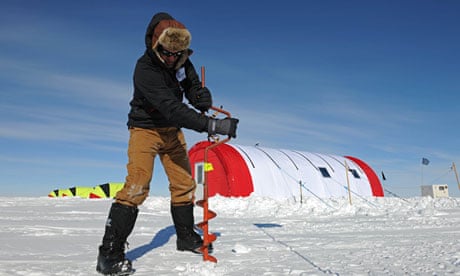An ambitious plan by a team of British scientists at the Antarctic to look for life in a lake buried under almost two miles of ice was abandoned this week, after a decade of preparation and almost a month of drilling.
Speaking to the Guardian from Antarctica, Prof Martin Siegert of the University of Edinburgh said he made the "sad decision" to halt the project in the early hours of Christmas Day, after the drilling did not go according to plan. He said the scientists remained committed to the project, however, and would return to complete the job, though that might take at least four or five years. "You don't do this kind of research without thinking about the risks involved," he said. "It is the cutting edge of science."
Scientists from the British Antarctic Survey flew to the site above Lake Ellsworth on the West Antarctic ice sheet in early December, joining a team of engineers who had already set up camp with the drilling equipment. They planned to use a hot-water "drill" to cut through the ice cap and sample the contents of the lake, which is liquid because of the extreme pressure of the ice on top of it. By looking for any forms of life in the water, which has been cut off from the rest of the world for anything up to a million years, they hoped to find clues about the evolution of life on Earth and, perhaps, the possibility of life on other planets.
"We need an awful lot of water to melt down 3km," said Siegert. "The technique we use to establish a reservoir is to create a cavity, with another borehole, 300 metres beneath the ice surface. That was done very successfully.
"What we then have to do is, with the main borehole, drill very close to the first one and make sure that it goes directly into the cavity and once we've achieved that hydrological link, we can then continue to go further, using the water in the main reservoir. If we didn't make the cavity, we cannot go on with the experiment."
Though the team were able to create the initial cavity and keep it open for 40 hours, they were unable to locate it to make the link with the main borehole, which was drilled only 2 metres away from the first. "In hot water drilling, it's often the way that you don't hit [the cavity] first time and you have to go back up. It might well have been that the cavity was a different shape than we expected. It might be that, simply, we were unlucky this time."
Siegert said he was disappointed, given the decade of preparation and testing, but that the team was resolved to try again. "The science aims haven't changed and we want to explore the glacial Lake Ellsworth, see if there's life in that extreme environment. The scientific drivers of this work remain unchanged; we are as committed to wanting to understand the research at Lake Ellsworth as ever we were."




Comments (…)
Sign in or create your Guardian account to join the discussion